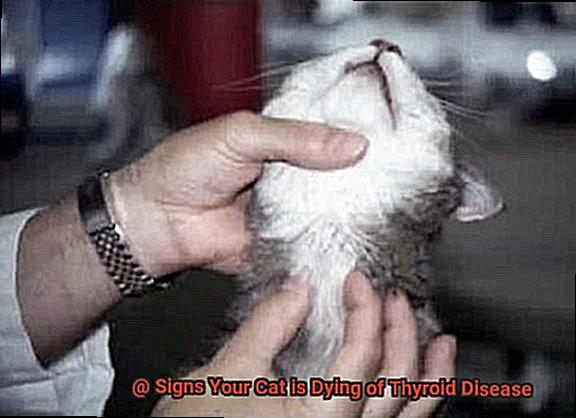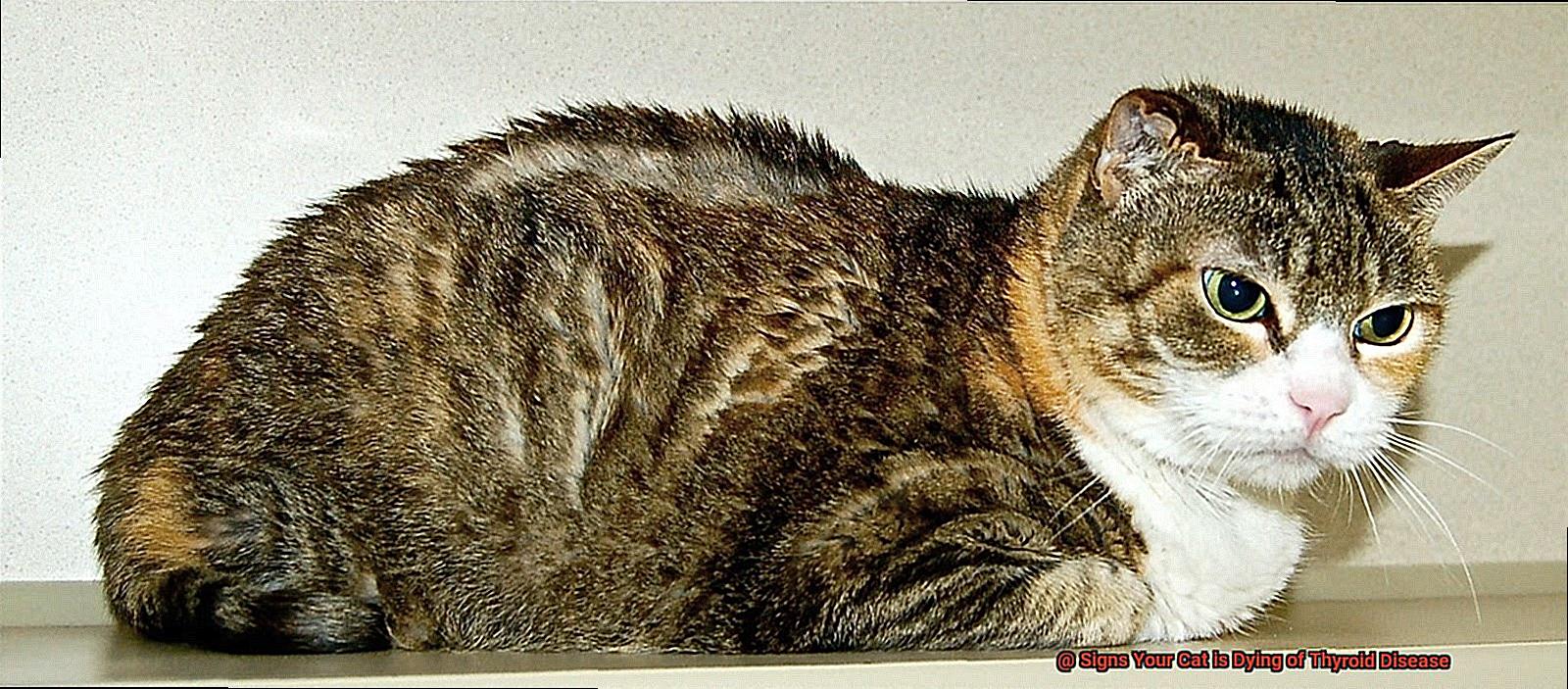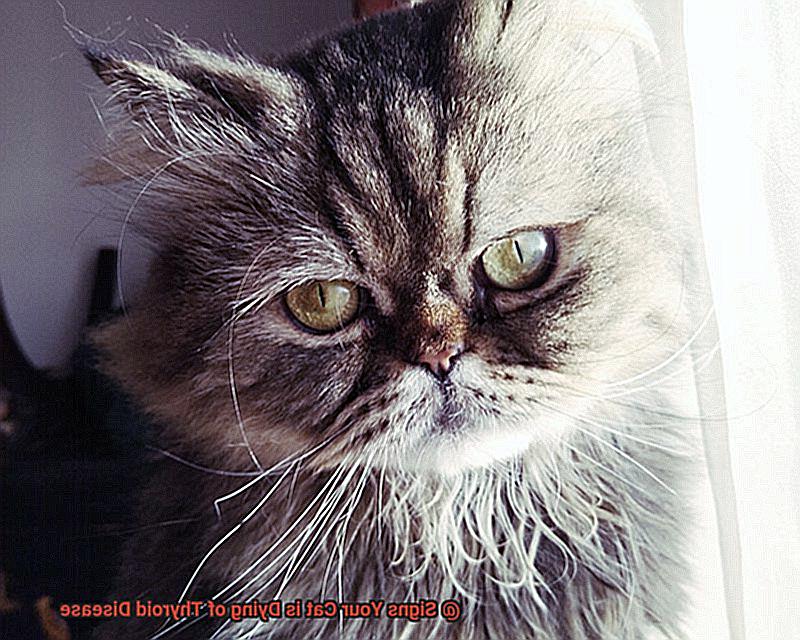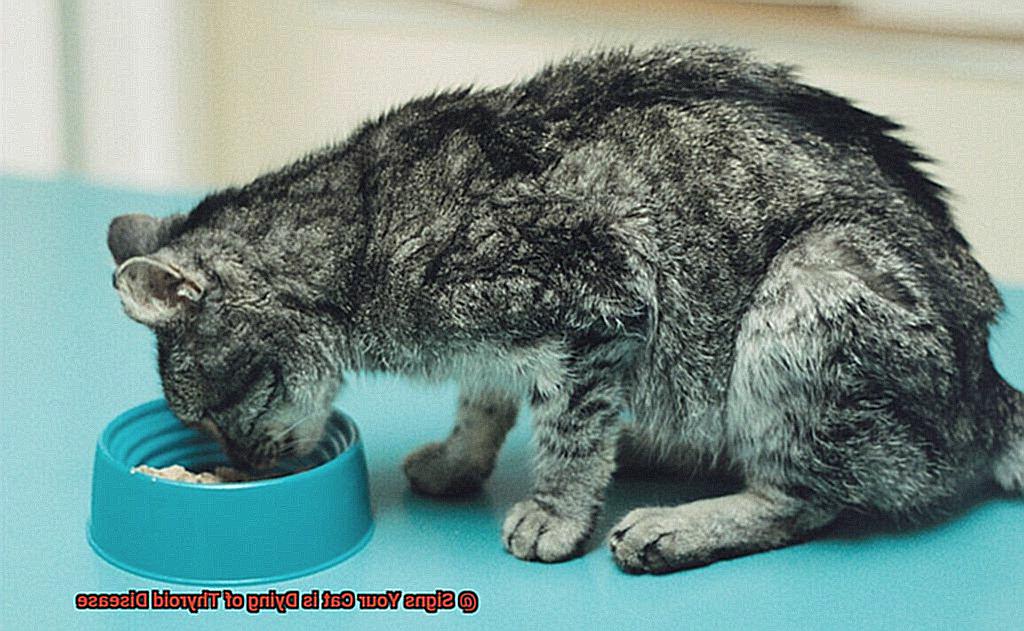Calling all cat lovers. Have you noticed anything unusual about your furry friend lately? Perhaps they’re shedding weight, guzzling more water than usual, or displaying odd behaviors. If so, it’s possible that your cat is suffering from thyroid disease – a serious condition that can have devastating effects on their health if left untreated.
Thyroid disease is a common ailment among cats and occurs when the thyroid gland, which regulates metabolism, malfunctions. This malfunctioning can lead to numerous health issues such as vomiting, heart failure and weight loss.
So how do you know if your cat has thyroid disease? Luckily, there are several signs to look out for that could save your pet’s life. In this blog post, we’ll go through the most common symptoms of thyroid disease in cats and what you can do to help your feline friend if they’re suffering from this condition.
From changes in behavior to excessive thirst, don’t miss out on the warning signs that could indicate your cat is dying of thyroid disease. As a devoted pet owner, it’s essential to stay informed and vigilant about your cat’s health and happiness.
Symptoms of Hyperthyroidism in Cats
This hormonal disorder is quite common in cats and can lead to severe consequences if left untreated. Therefore, early detection and prompt veterinary care are crucial.
One of the most apparent indications of hyperthyroidism in cats is weight loss, despite having a ravenous appetite. It’s like your cat is running on empty, burning calories at an accelerated rate without replenishing them, resulting in significant weight loss.

As the disease progresses, other symptoms may emerge, such as vomiting and diarrhea. Your cat’s digestive system may become compromised, leading to digestive issues. In severe cases, your cat may face dehydration and malnutrition, making it difficult for them to eat or drink.
Another visible symptom of hyperthyroidism is a dull and unkempt coat. The thyroid hormones play a vital role in regulating hair growth and skin health. As hormone levels become imbalanced, hair growth may slow down or even stop altogether.
Apart from these physical symptoms, behavioral changes may also occur in hyperthyroid cats. They may become restless, hyperactive, and irritable. They may exhibit unusual vocalizations or even aggressive behavior towards other animals or people.

If you suspect that your cat may be suffering from hyperthyroidism, seek veterinary care right away. Early diagnosis and treatment can significantly improve your cat’s quality of life and prevent long-term health complications.
However, do keep in mind that these symptoms could also indicate other underlying health conditions. Therefore, it is crucial to have your cat checked out by a veterinarian for an accurate diagnosis.
Weight Loss as a Sign of Thyroid Disease in Cats
If so, it could be a sign of thyroid disease in cats. As an expert on this topic, I’m here to share with you why weight loss is a critical symptom of thyroid disease and why seeking veterinary care is essential.
Thyroid disease is a common hormonal disorder in cats that affects the thyroid gland’s ability to regulate metabolism. Hyperthyroidism is a condition that arises when the thyroid gland produces too much thyroid hormone, which leads to an overactive metabolism.

Weight loss is one of the earliest signs of hyperthyroidism in cats. Your cat may be shedding pounds even though they are eating more than usual because their metabolic rate has increased, resulting in their body burning calories faster than they can consume them.
It’s important to understand that not all cats with thyroid disease will experience weight loss. In some cases, they may maintain their weight or even gain weight due to an increase in appetite and food intake. However, if your cat is losing weight rapidly or consistently over time, it could be a sign of hyperthyroidism.
Weight loss in cats can also be caused by other health issues such as diabetes, kidney disease, or cancer. That’s why it’s crucial to have your cat examined by a veterinarian if you notice any significant changes in their weight.
If left untreated, hyperthyroidism can lead to severe weight loss and muscle wasting. In some cases, the weight loss can be so severe that the cat becomes emaciated and weakened, resulting in a poor quality of life. Therefore, seeking veterinary care as soon as possible is vital to manage the symptoms and improve your cat’s quality of life.

In conclusion, weight loss is a critical symptom of thyroid disease in cats that should not be ignored. If you observe any unusual changes in your cat’s weight or overall health, take them to the vet for a thorough examination and diagnosis.

Vomiting and Diarrhea as Signs of Thyroid Disease in Cats
Hyperthyroidism is a condition where the thyroid gland produces an excess of hormone, causing your cat’s body to speed up. This can lead to a range of symptoms, including weight loss, increased appetite, and, of course, vomiting and diarrhea. These symptoms can occur in the early stages of hyperthyroidism or in the later stages when the disease has progressed.

If you notice any of these symptoms in your cat, it’s critical to take them to the vet for a comprehensive examination. The vet will likely run blood tests to check your cat’s thyroid hormone levels and determine if hyperthyroidism is the cause of their symptoms.
If hyperthyroidism is diagnosed early on, there are treatments available that can help manage the disease and reduce these symptoms. However, if left untreated and allowed to progress, vomiting and diarrhea may become more severe and difficult to manage.
In some cases, your cat may even refuse to eat or drink, leading to dehydration and other complications. Therefore, it’s crucial to work closely with your vet to monitor your cat’s condition and adjust their treatment plan as needed.
Ultimately, if your cat’s quality of life is severely impacted by their thyroid disease and they are no longer able to enjoy normal activities or maintain a good quality of life, you may need to consider euthanasia.
This decision should be made in consultation with your vet and based on what is best for your cat’s well-being.
Coat Changes as a Sign of Thyroid Disease in Cats
If you’ve noticed your cat’s once luscious fur looking thinner, duller, or greasier, it could be a sign of hyperthyroidism. This condition causes the body to speed up, resulting in a range of symptoms including weight loss, increased appetite, and changes to your cat’s coat.
Hyperthyroidism can increase the production of sebum, an oily substance that is secreted by the skin’s sebaceous glands. This can make your cat’s coat look unkempt and greasy. Additionally, hyperthyroidism can make your cat’s skin thin and fragile, which can contribute to hair loss and matting.
It’s crucial to remember that not all coat changes are caused by thyroid disease. Allergies or skin infections can also affect a cat’s fur and skin. That’s why it’s essential to have your cat examined by a veterinarian if you notice any changes in their coat.
If your vet does diagnose hyperthyroidism, there are several treatment options available. These may include medication, dietary changes, or even surgery or radioactive iodine therapy. With appropriate treatment, many cats with hyperthyroidism are able to recover and return to their normal selves.
However, if left untreated, hyperthyroidism can lead to serious complications and even death. That’s why it’s crucial to seek veterinary care as soon as possible if you suspect your cat may be suffering from this condition.
Diagnosing and Treating Thyroid Disease in Cats
If you’ve noticed hyperactivity, weight loss, or a dull coat, it could be a sign of hyperthyroidism. But don’t fret, because diagnosing and treating this condition can put your kitty on the path to recovery in no time.
The first step is a visit to the vet for a thorough physical examination and blood work. Elevated levels of thyroxine (T4) in the blood are a clear indication of hyperthyroidism. Other tests like a radioactive iodine uptake test or a thyroid ultrasound may also be done to determine the size and condition of the thyroid gland.
Once diagnosed, there are several options available for managing hyperthyroidism. Medication can be used to manage symptoms and reduce thyroid hormone levels. Surgery involves removing all or part of the thyroid gland, but it may not be suitable for all cats.
The gold standard for treating hyperthyroidism in cats is radioactive iodine therapy. This safe and effective procedure involves administering a small amount of radioactive iodine which destroys overactive thyroid tissue while leaving healthy tissue intact. With a success rate of up to 95%, it’s an excellent option for treating hyperthyroidism.
Early diagnosis and treatment are essential for improving your cat’s quality of life and minimizing the risk of serious complications. So if you suspect that your cat may have hyperthyroidism or any other medical condition, don’t hesitate to consult with your veterinarian right away.
When Should a Hyperthyroid Cat Be Put Down?
It’s essential to take the time to carefully consider the cat’s quality of life and overall health before making any decisions.

While hyperthyroidism is treatable with medication and proper care, sometimes, euthanasia may be the most humane option for a hyperthyroid cat. If your cat is experiencing severe symptoms such as vomiting, diarrhea, and seizures that can’t be controlled with medication, it may be time to consider this option.
Moreover, if your cat is suffering from other health issues such as kidney disease or heart failure, putting them down may also need to be considered. As a loving pet owner, you should consult with a veterinarian who can help you make an informed decision that aligns with your values and beliefs.
It’s important to note that hyperthyroidism is treatable, and if caught early enough, cats can live for many more years with proper medication and care. However, if your cat’s quality of life is significantly diminished, and they’re in severe pain, euthanasia may be the kindest option.
Before making any decisions about end-of-life care for your beloved pet, consider all options and consult with a veterinarian who can guide you through the process.
How Do I Know if My Cat is Suffering?
The truth is, cats are experts at hiding their pain, which makes it challenging for pet parents to detect any signs of distress. However, with the right knowledge and a keen eye, you can identify subtle changes in your cat’s behavior and physical symptoms that may indicate discomfort or pain.
Some common tell-tale signs of discomfort or pain in cats include lethargy, loss of appetite or weight, excessive grooming or hiding, changes in litter box habits, difficulty breathing or vocalizing, and aggression or avoidance of human interaction. Keep in mind that some cats may show no obvious signs of distress even when suffering from a serious illness. Therefore, it’s crucial to schedule regular check-ups with a veterinarian to monitor your cat’s health.
If you suspect that your cat may have thyroid disease, specific symptoms can help you identify the issue. Hyperthyroidism in cats can cause an increase in appetite, weight loss despite increased eating, increased thirst and urination, vomiting, diarrhea, hyperactivity, and restlessness.
These symptoms can also overlap with other common illnesses in cats such as kidney disease. Therefore, it’s essential to consult with a veterinarian for proper diagnosis and treatment.
It’s also important to consider your cat’s quality of life when determining if they are suffering.
If their condition is impacting their ability to enjoy daily activities or causing them frequent discomfort or pain, it may be time to consider humane euthanasia. However, this decision should always be made in consultation with a veterinarian and based on the individual needs and circumstances of your cat.
Remember, taking care of your cat’s health is a shared responsibility between you and your veterinarian. Regular check-ups and being vigilant about any changes in behavior or physical symptoms can help detect any issues early on.
How Long Can a Cat Live With Thyroid Problems?
So, when it comes to thyroid problems, it’s natural to wonder how long your cat can live with this condition. The good news is that with proper treatment and management, a cat with hyperthyroidism can live for many years.
However, it’s important to note that the severity of the condition plays a crucial role in determining your cat’s lifespan. Without prompt treatment or if the disease progresses to a more severe stage, your cat’s lifespan may be significantly shortened. On the other hand, cats that receive early and effective treatment can live for many years and often reach their normal lifespan.
Think of it like a well-maintained car that has regular tune-ups and maintenance – your cat also needs regular check-ups and monitoring of thyroid levels to ensure their condition remains under control. Failing to provide proper care may result in long-term health effects such as heart disease and kidney problems later in life.
So, what should you do if your cat has been diagnosed with hyperthyroidism? It’s important to work closely with your veterinarian to develop a personalized treatment plan for your cat. This could involve medication, dietary changes, or even surgery in some cases. Regular check-ups and monitoring of thyroid levels can help ensure that any potential complications are addressed promptly.
71cEVpqaT_A” >
Conclusion
To sum up, keeping yourself informed about the symptoms of thyroid disease in cats is crucial for every cat owner. This condition can have severe consequences on your feline’s health if left untreated. From vomiting and diarrhea to weight loss, there are numerous signs to watch out for that could save your pet’s life.
It is essential to seek veterinary care promptly if you suspect that your cat may be suffering from hyperthyroidism or any other medical issue. Remember, taking care of your cat’s health is a shared responsibility between you and your veterinarian.
With proper treatment and management, a cat with hyperthyroidism can live for many years. However, it’s important to work closely with your veterinarian to develop a personalized treatment plan for your cat. Regular check-ups and monitoring of thyroid levels can help ensure that any potential complications are addressed promptly.
Ultimately, as devoted pet owners, we all want our furry friends to live long and happy lives by our side. By staying vigilant about their health and seeking prompt veterinary care when necessary, we can achieve this goal.







